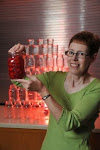Resources for Home Food Freezing of Produce
Freezing is the easiest, most convenient, and least
time-consuming method of preserving foods. Adding these to the frozen bounty of
the past fall's harvest makes for tightly packed freezers. You can freeze
almost any foods and a list of foods and freezing instructions can be found
here: http://www.uga.edu/nchfp/how/freeze.html. For
a table of foods that don't freeze well see: http://www.uga.edu/nchfp/how/freeze/dont_freeze_foods.html.
Freezing to fend
off food spoilage
Food spoilage is caused by microorganisms, chemicals, and
enzymes. Freezing foods to 0 degrees F. is recommended for best quality.
o
Freezing stops the growth of microorganisms;
however, it does not sterilize foods or destroy the organisms that cause
spoilage. A few organisms may die, but once thawed to warmer temperatures,
these organisms can quickly multiply.
o
Chemical changes affect quality or cause
spoilage in frozen foods. One major chemical reaction is oxidation. If air is
left in contact with the frozen food oxidation will occur even in the freezer.
An example is the oxidation of fats, also called rancidity.
o
Enzymes are naturally present in foods and their
activity can lead to the deterioration of food quality. Enzymes present in
animal foods, vegetables and fruit promote chemical reactions, such as
ripening. Freezing only slows the enzyme activity that takes place in foods. It
does not halt these reactions which continue after harvesting. Enzyme activity
does not harm frozen meats or fish, but browning can occur in fruits while they
are being frozen or thawed.
Blanching
Blanching vegetables before freezing inactivates the
enzymes. During blanching, the vegetable is exposed to boiling water or steam
for a brief period. The vegetable is then rapidly cooled in ice water to
prevent cooking. Following the recommended times for blanching each vegetable
is important. Over-blanching results in a cooked product and loss of flavor,
color, and nutrients. Under-blanching stimulates enzyme activity and is worse
than no blanching at all.
Chemical Treatment
of Fruits
Fruits may also be steamed or cooked before freezing, but
are more commonly treated with ascorbic acid to inactivate enzymes responsible
for browning. See freezing recommendations for individual foods for specific
recommended ascorbic acid usage: http://nchfp.uga.edu/how/freeze.html and http://nchfp.uga.edu/publications/uga/uga_freeze_fruit.pdf
for more information.
Packing and
Packaging
Packing methods include dry packs, syrup packs, sugar
packs, or possibly crushed or cooked packs. Each has advantages and
disadvantages. Pectin or artificial sweeteners are offered as options for
specific fruits. See freezing recommendations for individual foods for specific
recommended packs: http://www.uga.edu/nchfp/how/freeze.html or http://www.uga.edu/nchfp/publications/uga/uga_freeze_fruit.pdf
or http://www.uga.edu/nchfp/publications/uga/uga_freeze_veg.pdf
for more information.
Good packaging will help prevent air from entering the
container and moisture loss. Severe moisture loss, or ice crystals evaporating
from the surface of a product, produces freezer burn -- a grainy, brownish or
white surface where the tissues have become dry and tough. Freezer-burned food
is likely to develop off flavors, but it will not cause illness. Packaging in
air-tight rigid containers or heavyweight, moisture-resistant wrap will prevent
freezer burn. See: http://www.uga.edu/nchfp/how/freeze/containers.html
for more specifics.
Safe Defrosting
Never defrost foods on the kitchen counter, in a garage,
basement, car, dishwasher or outdoors. These methods can leave your foods
unsafe to eat. There are three safe ways to defrost food: in the refrigerator
at 40 degrees Fahrenheit or lower, in the microwave immediately before cooking,
or in running cold water for very short periods of time. Foods thawed in the
microwave or by the running cold water method should be cooked thoroughly
immediately after thawing occurs.
Using and Cooking
Frozen Foods
Frozen fruits are often eaten without cooking. Many are
best if eaten while they still contain a few ice crystals. Vegetables may be
cooked after thawing or while still frozen. Raw or cooked meat, poultry or
casseroles can be cooked or reheated from the frozen state. However, it will
take approximately one and a half times the usual cooking time for food that
has been thawed. Always cook foods to the recommended internal temperature
using a food thermometer.
The original version of this page written by Brian A.
Nummer, Ph.D., National Center for Home Food Preservation, 2004. Revised
November 2012 by Elizabeth L. Andress, Ph.D. and Kasey Christian, M.Ed.




No comments:
Post a Comment